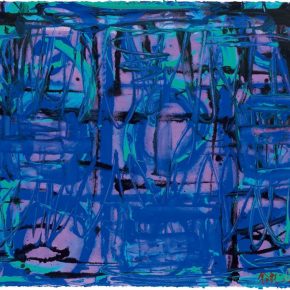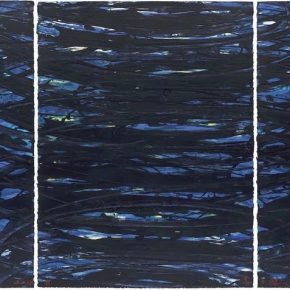
The life of Prof. Jin Rilong is occupied with figurative art, abstract/conceptual art and video/installation art: from a young prizewinner to a CAFA student, then from a South Korean university PhD holder to a prestigious Chinese professor. His career tells of not only a learner’s consistent toil in new styles and material but also an insightful reflection on contemporary scholasticism, a survey of contemporary art trends and more.
Interviewee: Prof. Jin Rilong (“Jin”)
Interviewer: Zhu Chunhua (“Zhu”)
It's abridged from the original Chinese version and edited by Sue/CAFA ART INFO.
Young Prizewinner
Zhu: Could you tell us about your days in CAFA in the 1980s?
Jin: I graduated from a polytechnic school in 1980. My major was fine arts and at the time we had kind of an omnibus syllabus. That year I had the chance to paint an oil painting entitled Grandma. As you know, mainstream art at that time favored positive, heroic figures. This work appeared before Master Luo Zhongli at Sichuan Fine Arts Institute where he released his famous work Father and Gao Xiaohua released Why. It did not represent the figure from the face on perspective, but from the back of a humpbacked woman. The government attached importance to the First National Ethnic Minority Fine Arts Exhibition. China Artists Association (CAA) delegates personally visited my school to collect paintings. I was a new graduate, but there were so many veteran artists in and around my community. While the overwhelming majority of them portrayed smiling diligent laborers or festive scenes, I highlighted the hump of the old woman who was looking for her grandson. Surprisingly I got the first prize, the equivalent of the present-day gold prize. It was a great honor for a polytechnic grad to win such an honor. Then I received the attention of the local Publicity Department. They gave me a Korean ethnic costume as an award when I was going to visit Beijing. This was a great turning point in my life.
CAFA Student
Zhu: Could you tell us about your school life?
Jin: My life at the college was very interesting. Before matriculation I had won a national honor. There were very few publications, and once distributed they circulated quickly nationwide. Since I had captured a great honor before the exam, it was quite a stressful step for an unprepared young man to consider what to do next to go further. My college life was fairly plain sailing and that’s why I have made it through to this day.
Zhu: Fine Arts Studies published your Do-ra-ji (Korean: Bellflower), six paintings in a series, as cover pictures. Comic Strip also published your work The Festivity of the Korean People. Both tended to be realistic works.
Jin: I was first assigned to the First Studio and majored in realism. I was very lucky, I imagine, because there was always a way out whenever I was in difficulties. Since then I managed to communicate effectively with others in art. In popular terms, it’s called symbolism. Of course there was no such concept as “symbolism” in those days. I often tell graduates about the great importance of the graduation project: this is when you are given the chance to re-assemble what you have learned in school, and it will be a summary of the languages and symbolism you have mastered.
For many reasons I make a point of hard work, or labor, when it comes to creating works. Inspiration and skill alone are not enough, they have to be accompanied with good luck. I’ve always believed in fortune apart from ingenuity. Fortune represents an energy that can be integrated to reflect the labor. I tell my students that great works are impossible without hard labor. My whole college life was spent pursuing representationalism, something like figurative art but in an exceedingly hyperbolic proportion.
Abstractionism and Conceptualism
Zhu: Why did you choose to study in South Korea after 1996?
Jin: In those days fine arts graduates had very different ideals from now. It’s not a matter of bread and butter. To be honest, I had such an obsession with painting so I would go anywhere as long as I could pursue my art career there. Then I ended up in COSTIND (Commission for Science, Technology and Industry for National Defense). A decade later I returned to my Alma Mater as an associate professor while many who graduated with me had not attained the honor. Of course I didn’t go to COSTIND to earn the title. It was the same with my previous years. I did it with an emotional attachment. In the end, I received even more.
China had just introduced diplomatic ties with South Korea at the time. Deng Lin (Deng Xiaoping’s daughter; a painter with China National Academy of Painting (CNAP)) and I, along with three other painters, visited Seoul National University (SNU) to exhibit some works. I asked to pursue studies in SNU and this was approved thanks to my passable language ability and my status as a CAFA student. I must go abroad to learn more and improve myself. Making a living is not difficult for me, but it’s meaningless to stay where you are for the mere sake of livelihood. When I came home, I have already started a job at the South Korean university. When I returned home, Mr. Jin immediately recommended me to CAFA. Although China has international pay level nowadays, but the pay gap between South Korean and China at that time was very insignificant. To stay in South Korea would have been a pretty good choice, but I was a staunch CAFA supporter. But the decision lay with CAFA, not me. So I was very happy to come back as soon as possible. Then I finished the thesis, passed the oral defense exam and came home. So far I’ve worked in CAFA for more than a decade.
Zhu: What struck you most deeply during the years in South Korea?
Jin: The years in South Korea were very meaningful, for the country had very close ties with the U.S. and was ahead of us in modern art at that time. It had kept up with the U.S. in this field even before we opened our doors to the world. Besides, out of all our Asian neighbour Korean art was best assimilated into our culture, better than Japanese art. Korean art did a lot to improve my style. Sometimes certain avant-garde styles are too abstract to understand. Korean art was just in between, so I embraced it and assimilated these with no great difficulty.
I rather appreciated how the South Koreans perceived and assimilated abstract art. The change was very significant to me. My road is an ongoing process to turn from figuratism to representationalism. To be specific, I belong to the conceptual genre, rather than abstractionanism. It’s an evolution from abstract art to installation art and then to video art. To my way of thinking, artists toil hard to enjoy. You can’t impress your audience without such an endeavor. Perhaps I don’t influence my peers as expected with the repeating process, but I have a longstanding conviction that drives me back home to be myself. From the brush and colors I derive a sense of pleasure, or a sense of tempo, or something of a sudden inspiration. It’s not put on the canvas until it has completely taken shape, otherwise the achievement of the objective would be impossible. The inspiration may well have arisen during the creation of the work. It’s well defined in the conflict, or chaos, of the pictures. Finally, the ideas settle down and take shape. The process can be likened to a dialogue.
Installation Art as a Form of Media
Zhu: When did you take up installation art and video art?
Jin: I was not content with painting alone. One day I was enjoying some installation work when I hit upon the idea. Why not go beyond oil on canvas? So I designed my own work for display in South Korea. I reproduced one of my paintings in the form of a physical object, painted it and made a shape to hang from strings. While it largely imitated other works, I succeeded all the same. I dare say I’m the first in China to have made it. Normally, sculptors and print makers are more readily receptive to media. It’s the same in foreign art circles. Art is inseparable from the media forever. Oil painting, I imagine, is a form of media like the computer. In the past artists used egg whites and oils. Later acrylic paint was used. All these are forms of media. Finally, the computer was invented to represent the subtleties in a more vivid way. Why did artists paint? To record images. However, developments in photography are displacing traditional painting. There will be no place for the brush, for the photo is larger than life. At this point art must go beyond images. Such pursuits are always exciting and drive one ahead.
Art in Permanent Present Continuous Tense
Zhu: You talked about contributing to society on many occasions. Will you exhibit more art works in the future for the public good? We know that quite a lot of CAFA exhibitions are unintelligible to the general public.
Jin: Modern art is quite different. While we are still alive, it is imperative for an artist to communicate with society and more actively engage with the system after being recognized. An artist must avoid being self-centered. I used to comment after finishing a work, but art is in a permanent “present continuous tense”. It’s very important for an artist to realize the impropriety of the premature comment.
About Jin Rilong
Born on Feb. 22, 1962
Titles:
CAFA Professor and Director of Personnel Department
Deputy Director of Comics and Cartoon Committee, China Artists Association
Deputy Director of the Paintings, Comics & Cartoons Judge Committee of the 12th National Fine Arts Exhibition
Deputy Director of the Beijing Fine Arts Colleges Human Figure Design Alliance
Résumé
2015-Present: Professor, CAFA Design School
2010-2014: Deputy Dean, CAFA Design School
2005-2015: Associate professor, CAFA Design School
2002-2004: Lecturer, College of Fine Arts, Hongik University
2001-2003: Lecturer, Kongju National University College of Fine Arts
1986-1996: Deputy Photo Editor, Shenjian Editorial Room of the Political Division of COSTIND (now General Armament Dept.)
Education:
Mar. 1, 2001-Aug. 26, 2005: Doctoral of Fine Arts, Hongik University Doctoral Program
Mar. 1, 1996-Feb. 26, 2000: Master of Fine Arts, Seoul National University Graduate School
Sept. 1, 1982-Jul. 1986: Bachelor of Fine Arts, CAFA Department of Oil Painting
Courtesy of the artist.

















































